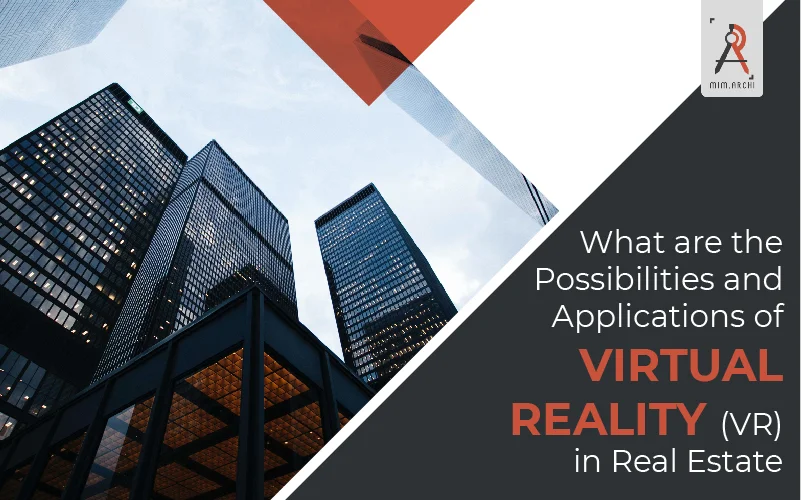
What are the Possibilities and Applications of VR in Real Estate?
Do you have any experience buying or selling properties? If so, you will be familiar with VR in real estate by 2022. In the real estate industry, virtual tours and virtual staging are gaining attraction through virtual reality and augmented reality technologies.
Real estate industry is just starting to use virtual reality tools as effective ways to communicate and market their business. There is an increasing amount of capital dedicated to augmented and virtual reality technology as they have the potential to make a significant impact on the real estate industry. Both developers and potential buyers can gain benefit from the virtual tours and virtual staging technologies. In order to stay ahead of the curve, real estate players should consider implementing virtual reality interactions.
Do you want to know more about how realtors can use virtual reality to sell real estate? If so, keep reading!
Uses of VR in Real Estate
A 360 virtual tour of a property is a great way for prospective buyers or tenants to see the property, saving them both time and travel expenses. With VR, the staging of a property can also be virtually executed. Virtual reality technology, on the other hand, makes it possible for real estate agents to show prospective buyers fully furnished properties even if the spaces are empty in person.
Most people view virtual reality as a form of entertainment and video games. In reality, virtual reality can play a crucial role in the real estate sector. Here are a few of its most popular uses.
• Property showcases on virtual reality
Clients usually view several properties before selecting one. In case a property is far from a client’s residence, this task requires a great deal of time. As a result, visiting a property is not just time-consuming, but also costly.
Virtual reality solves these problems, allowing millions of people to virtually tour properties, all from the comfort of their home. You can walk into properties in an immersive, three-dimensional way by simply putting on a VR headset. In a matter of minutes, a potential buyer or tenant can virtually view dozens of properties and decide which ones should be visited in person.
• Virtual Staging
Think about showing a bare property without any or almost no furnishings. Now imagine the exact same apartment or house outfitted with furniture and beautifully decorated. Of these, which would you find easier to sell? Obviously the first one.
While virtual staging can provide a great way to market your property, it requires investment, especially if you are selling a newly constructed house. It’s easy for real estate agents to make very little investment using virtual reality technology to market staged properties. MIMAR, for example, offers VR staging services to real estate agents.
VR in real estate lets you stage properties and create stunning 3D tours for your clients.
• Visualization of architectural projects
Real estate agents and developers have always found it challenging to market a property that hasn’t been built yet. A large 3D model showing a new property or neighborhood is probably familiar to you. It helps prospective buyers visualize the architecture.
Real estate agents make full-scale models of apartments available in large showrooms when it comes to the interiors of these new constructions. These marketing techniques, though, require considerable investment. This problem can be effectively solved by virtual reality, since it allows prospective homebuyers to explore both the exterior and interior of still-to-be-built properties.
VR has made 3D architectural visualization cheaper and more immersive than it was before. With virtual reality, real estate agents can show prospects not yet built properties from the outside and from the inside, so their clients can get a better sense of what is on offer.
• Directions for tenants in the virtual world
Managing properties and renting out apartments require constant communication with tenants. It may seem like a simple task, but what if you’re constantly getting calls from your clients asking how to use the thermostat or where a switch is? This can be a problem for companies offering short-term vacation rentals.
Landlords can communicate with tenants more efficiently using virtual reality technology. Putting on a VR headset allows tenants to experience 3D virtual tours. Despite the fact that it takes a little time, this can be extremely helpful because of its immersive nature.
By viewing a 3D real estate tour, tenants can gain a better understanding of how utility services at a property work, thereby avoiding unnecessary contact with the landlord.
Note: Mimar is the one-stop solution for all your real estate services.
Benefits Of Using VR in Real Estate Industry
1- It Saves your Time
Virtual reality solutions are considered to be the biggest benefit – they save realtors and client’s time. You don’t have to rely on the transportation network or sit in traffic jams to travel between properties. Clients can instead wear virtual reality headsets to feel immersed in 3D environments.
You might doubt whether virtual reality is worth it no matter how many practical uses you already know. In fact, it is. Check out our list of virtual reality’s biggest benefits for real estate agents to see what we mean.
2- Connects you emotionally
Clients can visualize properties by viewing virtual tours of houses and apartments. While traditional home tours occur while everyone is in a hurry, VR tours are available at convenient times when potential buyers can focus on details.
Virtual house tours provide a lot more immersive experience for clients and create an emotional connection than conventional 2D images, which may not represent a property’s real appearance.
3- Provides global reach
It is well known that real estate agents need a lot of time to help each client. As a realtor, you are constantly scheduling visits, showing properties, and negotiating terms and prices, which is why you work with relatively few clients on average.
This can be changed by virtual reality. A virtual tour makes real estate agents more productive since most properties can be shown online. In addition, clients will be able to view properties from anywhere. In general, this means you can handle more client inquiries and work with more clients.
4- Reduces costs
Consider the investment in traditional real estate marketing compared to developing feature-rich 3D virtual tours. Besides staging properties, you should also produce high-quality pictures and print materials (especially when listing new properties).
You can use 360-degree videos and computer graphics to save a lot of money with virtual reality. In today’s digital age, a panoramic camera and simple rendering are all that is needed to make a guided video tour of a property.
Read Now: Top industries using VR in 2022.
Final Thoughts
Real estate has already started to undergo a transformation thanks to virtual reality. The VR benefits are likely to be implemented by more real estate agents in their work for efficiency. Visit our website (mimar.live) today to receive the latest info about how businesses can incorporate VR and other new technologies.
Mimar offers a comprehensive range of marketing tools for real estate, including AR and VR technologies.

